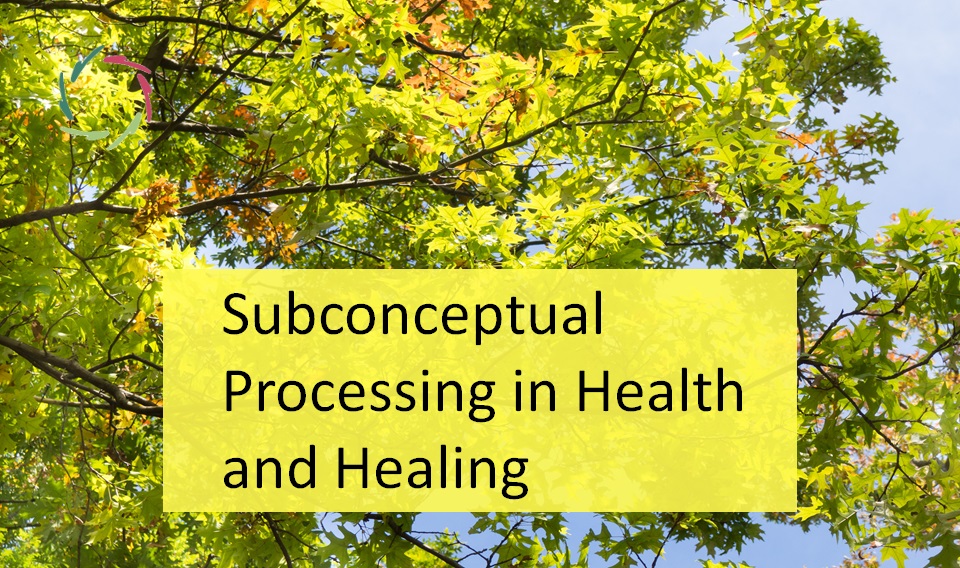Subconceptual Processing in Health and Healing (From My PhD Thesis)

People worldwide face enormous healthcare problems for which the more resources we focus on solving them, the worse they become. Many solutions give temporary relief, followed by further deterioration.
[see About ‘Subconceptual’]
Some examples are depression, obesity, psycho-somatic disorders and drug addiction.
Looking at pharmaceutical drugs.
In spite of the general view that these cure diseases, for the most part they only relieve symptoms. Only a few exceptional drug categories – antibiotics and chemotherapeutics – actually offer a cure. Of course, symptom relief may be a good thing in some cases. However, in domains such as psycho-somatics, this approach is highly problematic. Here, underlying issues often remain unmanaged and fester, while patients think that they are receiving the best care.
In this way, when we think we are drawing a solution towards us in the long term, we are often drawing it away.
This is shown in the figure below: when we pull on a string wrapped around a wheel, the solution is pulled in the opposite direction.

Whether the solution is drawn towards us or away from us depends on whether it lies above or below the horizontal bar in the middle. If it lies above the bar, it is drawn towards us, whereas if it is below the bar, it is drawn away. In this picture, conceptual processing lies above the bar, while below it lies subconceptual processing (SP). This hugely overlaps with the ‘nonconscious’. It’s also the domain of autosuggestion, as in AURELIS. The latter has been studied extensively in cognitive neuroscience.
This view depicts a reality with huge implications for many, and indeed most areas of health and healing.
When someone is given a placebo for pain,
fMRI shows that a number of their brain centers/regions become active – things are happening in the brain at the objective level. Simultaneously, they believe that the placebo will work – there is a parallel subjective effect. Indeed, the person feels less pain because they respond to the analgesic suggestion that accompanies the placebo. In a double-blind situation (placebo vs. active medication), the treatment assumption modulates their expectations. This is yet another example of how the mind and brain are inextricably intertwined – and in fact are one.
Interestingly, this is closely related to the effect of empathy between physician and patient
which can substantially relieve the feeling of pain. Considerable progress is now being made in our understanding of both empathy and placebo at the subjective level. However, there is still a need to ground these insights at a deeper level where the subjective and objective intersect. This is important, as it may give rise to healthcare developments that reduce costs substantially while relieving suffering in a sustainable way.
At present, there are huge gaps in medical knowledge.
Whether intentionally or unintentionally, a significant amount of effort goes into trying to conceal these gaps. On closer inspection many medical diagnoses do not identify specific diseases, but instead take some aspect of reality and put a label on it. As this approach is repeated systematically in psycho-somatics, the level of knowledge we actually have in medical science is highly overrated.
DSM-IV, and to an even greater extent DSM-V, are an example of this in psychiatry.
Despite many years of research, the biochemical foundations of depressive, schizophrenic, ADD and other numerous psychopathological conditions remain undetermined – see, for instance, the university textbook ‘Neuroscience, Exploring the Brain’ (Bear, Connors, & Paradiso, 2007). As an illustration, those who initially conceptualized ADHD warned against medicalizing it into a disease entity. However, for many medical professionals and laypersons, it is viewed as exactly that.
Depression: the serotonin hypothesis remains controversial at best
and the DSM criterion involves matching a certain number of characteristics out of a longer list – in other words it is a diagnosis that is made by convention. The issue, of course, is that if the serotonin hypothesis is not true, then what is it that underlies that which we call ‘depression’? In future, this gap may be filled by SP. At present, we don’t know if this is the case but any keen observer knows that depression is intimately related to a perceived lack of deeper meaning.
The fact that mental diseases are not clearly delineated is also demonstrated by the frequency of comorbidity between them, indicating that they might be better explained as highly overlapping conditions with fuzzy borders.
There are also gaps concealed in causal thinking.
When following a causal chain, many researchers and practitioners tend to stop systematically at material points in the chain, rather than at psychological ones – although this is often not done intentionally. The end result, however, is a situation where material etiologies form the majority of medical explanations, without the psyche being taken into account. Managing psychological aspects of a condition remains the role of care, not cure. In the best case, it is in the province of nursing, rather than residing in the hard, factual bastion of medical management.
Because of this, medicine is gradually retreating into an ivory tower
with advances serving a socioeconomic purpose, rather than a scientific and patient-centered one.
Western science traditionally views diseases as entities that exist within individuals. However, for a number of health issues, an alternative and potentially better approach is:
look at disease from an intrinsically social perspective.
In other words, a person does not ‘have a disease’, but instead they ‘show the disease’ (better termed a health issue) within an environment where the condition is not immediately and conceptually obvious, but instead plays itself out on a stage of overlapping subconscious patterns.


